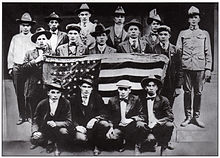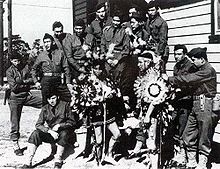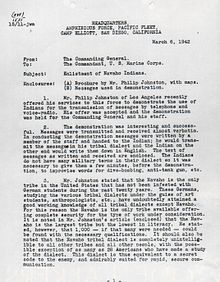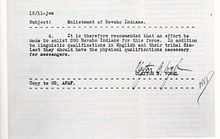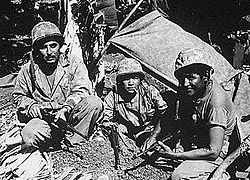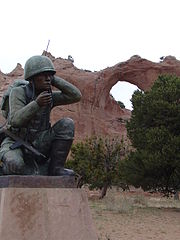- Code talker
-
"Codetalkers" redirects here. For the band, see The Codetalkers.
Code talkers was a term used to describe people who talk using a coded language. It is frequently used to describe 400 Native American Marines who served in the United States Marine Corps whose primary job was the transmission of secret tactical messages. Code talkers transmitted these messages over military telephone or radio communications nets using formal or informally developed codes built upon their native languages. Their service improved communications in terms of speed of encryption at both ends in front line operations during World War II.
The name code talkers is strongly associated with bilingual Navajo speakers specially recruited during World War II by the Marines to serve in their standard communications units in the Pacific Theater. Code talking, however, was pioneered by Choctaw Indians serving in the U.S. Army during World War I. These soldiers are referred to as Choctaw Code Talkers.
Other Native American code talkers were deployed by the United States Army during World War II, including Cherokee, Choctaw, Lakota[1] Meskwaki, and Comanche soldiers. Soldiers of Basque ancestry were used for code talking by the U.S. Marines during World War II in areas where other Basque speakers were not expected to be operating.
Contents
Use of Cherokee
The first known use of Native Americans in the American military to transmit messages under fire was a group of Cherokee troops utilized by the American 30th Infantry Division serving alongside the British during the Second Battle of the Somme. According to the Division Signal Officer, this took place in September 1918. Their outfit was under British command at the time.[2]
Use of Choctaw
In the days of World War I, company commander Captain Lawrence of the U.S. Army overheard Solomon Louis and Mitchell Bobb conversing in the Choctaw language. He found eight Choctaw men in the battalion.[3] Eventually, fourteen Choctaw men in the Army's 36th Infantry Division trained to use their language in code. They helped the American Expeditionary Forces win several key battles in the Meuse-Argonne Offensive in France, during the final big German push of the war. Within 24 hours after the Choctaw language was pressed into service, the tide of the battle had turned. In less than 72 hours the Germans were retreating and the Allies were in full attack.[3]
These soldiers are now known as the Choctaw Code Talkers.
Use of Comanche
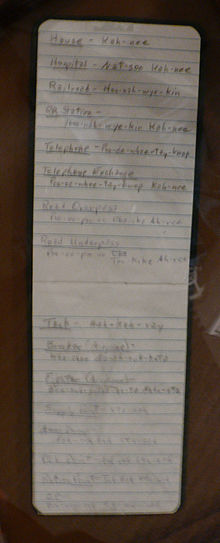 Hugh F. Foster Jr.'s Comanche codebook
Hugh F. Foster Jr.'s Comanche codebook
Adolf Hitler knew about the successful use of code talkers during World War I. He sent a team of some thirty anthropologists to learn Native American languages before the outbreak of World War II.[4] However, it proved too difficult for them to learn the many languages and dialects that existed. Because of Nazi German anthropologists' attempts to learn the languages, the U.S. Army did not implement a large-scale code talker program in the European Theater. Fourteen Comanche code talkers took part in the Invasion of Normandy, and continued to serve in the 4th Infantry Division during further European operations.[5] Comanches of the 4th Signal Company compiled a vocabulary of over 100 code terms using words or phrases in their own language. Using a substitution method similar to the Navajo, the Comanche code word for tank was "turtle", bomber was "pregnant airplane", machine gun was "sewing machine" and Adolf Hitler became "crazy white man".[6]
Two Comanche code-talkers were assigned to each regiment, the rest to 4th Infantry Division headquarters. Shortly after landing on Utah Beach on June 6, 1944, the Comanches began transmitting messages. Some were wounded but none killed.[6]
In 1989, the French government awarded the Comanche code-talkers the Chevalier of the National Order of Merit. On November 30, 1999, the United States Department of Defense presented Charles Chibitty with the Knowlton Award.[6][7]
Use of Meskwaki
Meskwaki men used their language against the Germans in North Africa. Twenty-seven Meskwaki, then 16% of Iowa's Meskwaki population, enlisted in the U.S. Army together in January 1941.[8]
Use of Basque
Captain Frank D. Carranza conceived the idea of using the Basque language for codes in May 1942 upon meeting about 60 U.S. Marines of Basque ancestry in a San Francisco camp.[9][10][11] His superiors were justifiably wary. There were 35 Basque Jesuits in Hiroshima, led by Pedro Arrupe. In China and the Philippines, there was a colony of Basque jai alai players and there were Basque supporters of Falange in Asia. The American Basque code talkers were kept from these theaters; they were initially used in tests and in transmitting logistic information for Hawaii and Australia.
On August 1, 1942, Lieutenants Nemesio Aguirre, Fernández Bakaicoa and Juanna received a Basque-coded message from San Diego for Admiral Chester Nimitz warning him of the upcoming Operation Apple to remove the Japanese from the Solomon Islands. They also translated the start date, August 7, for the attack on Guadalcanal. As the war extended over the Pacific, there was a shortage of Basque speakers and the parallel Navajo program came to be preferred.
Alphabets (English) Code Language (English) Code Language (Navajo) Modern spelling A Ant Wol-la-chee Wóláchííʼ B Bear Shush Shash C Cat Moashi Mósí D Deer Be Bįįh E Elk Dzeh Dzeeh F Fox Ma-e Mąʼii G Goat Klizzie Tłʼízí H Horse Lin Łį́į́ʼ I Ice Tkin Tin J Jackass Tkele-cho-gi Téliichoʼí K Kid Klizzie-yazzi Tłʼízí yázhí L Lamb Dibeh-yazzi Dibé yázhí M Mouse Na-as-tso-si Naʼastsʼǫǫsí N Nut Nesh-chee Neeshchʼííʼ O Owl Ne-ash-jsn Néʼéshjaaʼ P Pig Bi-sodih Bisóodi Q Quiver Ca-yeilth kʼaaʼ yeiłtįįh R Rabbit Gah Gah S Sheep Dibeh Dibé T Turkey Than-zie Tązhii U Ute No-da-ih Nóódaʼí V Victor a-keh-di-glini Akʼehdidlíní W Weasel Gloe-ih Dlǫ́ʼii X Cross Al-an-as-dzoh Ałnáʼázdzoh Y Yucca Tsah-as-zih Tsáʼásziʼ Z Zinc Besh-do-gliz Béésh dootłʼizh Philip Johnston proposed the use of Navajo to the United States Marine Corps at the beginning of World War II. Johnston, a World War I veteran, was raised on the Navajo reservation as the son of a missionary to the Navajos, and was one of the few non-Navajos who spoke their language fluently. Because Navajo has a complex grammar, it is not nearly mutually intelligible enough with even its closest relatives within the Na-Dene family to provide meaningful information, and was at this time an unwritten language, Johnston saw Navajo as answering the military requirement for an undecipherable code. Navajo was spoken only on the Navajo lands of the American Southwest, and its syntax and tonal qualities, not to mention dialects, made it unintelligible to anyone without extensive exposure and training. One estimate indicates that at the outbreak of World War II fewer than 30 non-Navajos, none of them Japanese, could understand the language.[12]
Early in 1942, Johnston met with Major General Clayton B. Vogel, the commanding general of Amphibious Corps, Pacific Fleet, and his staff. Johnston staged tests under simulated combat conditions which demonstrated that Navajos could encode, transmit, and decode a three-line English message in 20 seconds, versus the 30 minutes required by machines at that time. The idea was accepted, with Vogel recommending that the Marines recruit 200 Navajos. The first 29 Navajo recruits attended boot camp in May 1942. This first group then created the Navajo code at Camp Pendleton, Oceanside, California.[13] The Navajo code was formally developed and modeled on the Joint Army/Navy Phonetic Alphabet that uses agreed-upon English words to represent letters. As it was determined that phonetically spelling out all military terms letter by letter into words—while in combat—would be too time consuming, some terms, concepts, tactics and instruments of modern warfare were given uniquely formal descriptive nomenclatures in Navajo (the word for "potato" being used to refer to a hand grenade, or "tortoise" to a tank, for example). Several of these portmanteaus (such as gofasters referring to running shoes, ink sticks for pens) entered Marine corps vocabulary and are commonly used today to refer to the appropriate objects.
A codebook was developed to teach the many relevant words and concepts to new initiates. The text was for classroom purposes only, and was never to be taken into the field. The code talkers memorized all these variations and practiced their rapid use under stressful conditions during training. Uninitiated Navajo speakers would have no idea what the code talkers' messages meant; they would hear only truncated and disjointed strings of individual, unrelated nouns and verbs.
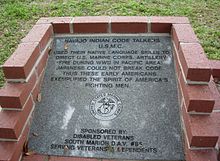 Code Talkers Monument Ocala, Florida Memorial Park.
Code Talkers Monument Ocala, Florida Memorial Park.
The Navajo code talkers were commended for their skill, speed and accuracy accrued throughout the war. At the Battle of Iwo Jima, Major Howard Connor, 5th Marine Division signal officer, had six Navajo code talkers working around the clock during the first two days of the battle. These six sent and received over 800 messages, all without error. Connor later stated, "Were it not for the Navajos, the Marines would never have taken Iwo Jima."[13]
As the war progressed, additional code words were added on and incorporated program-wide. In other instances, informal short-cut code words were devised for a particular campaign and not disseminated beyond the area of operation. To ensure a consistent use of code terminologies throughout the Pacific Theater, representative code talkers of each of the U.S. Marine divisions met in Hawaii to discuss shortcomings in the code, incorporate new terms into the system, and update their codebooks. These representatives in turn trained other code talkers who could not attend the meeting. For example, the Navajo word for buzzard, jeeshóóʼ, was used for bomber, while the code word used for submarine, béésh łóóʼ, meant iron fish in Navajo.[14]
The deployment of the Navajo code talkers continued through the Korean War and after, until it was ended early in the Vietnam War.
Cryptographic properties
Non-speakers would find it extremely difficult to accurately distinguish unfamiliar sounds used in these languages. Additionally, a speaker who has acquired a language during their childhood sounds distinctly different from a person who acquired the same language in later life, thus reducing the chance of successful impostors sending false messages. Finally, the additional layer of an alphabet cypher was added to prevent interception by native speakers not trained as code talkers, in the event of their capture by the Japanese. A similar system employing Welsh was used by British forces, but not to any great extent during World War II. Welsh was used more recently in the Balkan peace-keeping efforts for non-vital messages.
Navajo was an attractive choice for code use because few people outside the Navajo themselves had ever learned to speak the language. Virtually no books in Navajo had ever been published. Outside of the language itself, the Navajo spoken code was not very complex by cryptographic standards and would likely have been broken if a native speaker and trained cryptographers worked together effectively. The Japanese had an opportunity to attempt this when they captured Joe Kieyoomia in the Philippines in 1942 during the Bataan Death March. Kieyoomia, a Navajo Sergeant in the U.S. Army, but not a code talker, was ordered to interpret the radio messages later in the war. However, since Kieyoomia had not participated in the code training, the messages made no sense to him. When he reported that he could not understand the messages, his captors tortured him.[15] Given the simplicity of the alphabet code involved, it is probable that the code could have been broken easily if Kieyoomia's knowledge of the language had been exploited more effectively by Japanese cryptographers. The Japanese Imperial Army and Navy never cracked the spoken code.
Post-war recognition
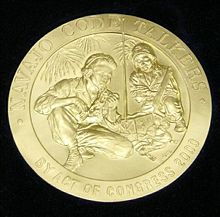 Congressional Gold Medal awarded to Navajo code talkers in 2000
Congressional Gold Medal awarded to Navajo code talkers in 2000 Monument to Navajo code talkers in Window Rock, AZ
Monument to Navajo code talkers in Window Rock, AZ
The code talkers received no recognition until the declassification of the operation in 1968.[16] In 1982, the code talkers were given a Certificate of Recognition by U.S. President Ronald Reagan, who also named August 14, 1982 "Navajo Code Talkers Day".[17][18]
On December 21, 2000 the U.S. Congress passed, and President Bill Clinton signed, Public Law 106-554, 114 Statute 2763, which awarded the Congressional Gold Medal to twenty-nine World War II Navajo code talkers. In July 2001, U.S. President George W. Bush personally presented the Medal to four surviving code talkers (the fifth living code talker was not able to attend) at a ceremony held in the Capitol Rotunda in Washington, DC. Gold medals were presented to the families of the 24 code talkers no longer living.[19]
On September 17, 2007, 18 Choctaw code talkers were posthumously awarded the Texas Medal of Valor from the Adjutant General of the State of Texas for their World War I service.[20] On December 13, 2007, H.R. 4544, the Code Talker Recognition Act, was introduced to the House of Representatives. The Code Talker Recognition Act recognizes every code talker who served in the United States military with a Congressional Gold Medal for his tribe, and a silver medal duplicate to each code talker, including eight Meskwakis.[21]
Popular culture
The 2002 movie Windtalkers was a fictional story based on Navajo code talkers who were enlisted in the U.S. Marine Corps in World War II. The movie was criticized for featuring the Navajo characters only in supporting roles, not as the primary focus of the film.[22] The film's plot was fabricated about white bodyguards being ordered to kill them should they fall into enemy hands.[23] It was further criticized for its use of stereotypes of both Native Americans and east Asians.[24]
The 1959 movie Never So Few features Charles Bronson as Sgt. John Danforth, a Navajo code talker.
The historical novel Code Talker portrays a group of Navajos serving in the Marine Corps in the Pacific Theater during World War II.
See also
- Native Americans and World War II
- Navajo Nation
- Navajo people
- Navajo language
- Southern Athabaskan languages
- Choctaw code talkers of World War I
- United States Army Indian Scouts
- Navajo I
Notes
- ^ Last Lakota code talker Clarence Wolf Guts dies at 86 Rapid City Journal. Rapid City, SD: 2010-06-18.
- ^ Stanley, Captain John W. Personal Experience of a Battalion Commander and Brigade Signal Officer, 105th Field Signal Battalion in the Somme Offensive, September 29 – October 8, 1997. U.S. Army, 1932.
- ^ a b "Choctaw Code Talkers of World War II". http://www.uwm.edu/~michael/choctaw/code.htm. Retrieved 2008-02-13.
- ^ NSA Code Talker Exhibit
- ^ "The Comanche Code Talkers". http://www.comanchelanguage.org/Comanche%20Code%20Talkers.htm. Retrieved 2008-02-13.
- ^ a b c Army History Research: 124th Signal Battalion Matthew J. Seelinger
- ^ Comanche Code Talker Charles Chibitty Dies
- ^ "Last Meskwaki code talker remembers". USA Today. July 4, 2002. http://www.usatoday.com/news/nation/2002/07/06/codetalkers.htm. Retrieved 2008-02-13.
- ^ "Egon arretaz egunari", Xabier G. Argüello, El País, August 1, 2004.
- ^ La orden de desembarco en Guadalcanal se dió en vascuence para que no lo descubrieran los nipones, Juan Hernani, El Diario Vasco, December 26, 1952, it quotes Revista General de Marina. Bibliographic reference in Euskomedia.
- ^ Los vascos y la II Guerra Mundial, Mikel Rodríguez, Euskonews & Media 301.
- ^ Volgel, Clayton. "Letter to Commandant, USMC". Demonstration in California, 1942. Northern Arrizona University, Cline Library. http://archive.library.nau.edu/u?/cpa,44718. Retrieved 20 July 2011.
- ^ a b NAVAL HISTORICAL CENTER, Navajo Code Talkers: World War II Fact Sheet
- ^ McLellan, Dennis (2011-07-24). "Joe Morris Sr. dies at 85; Navajo code talker during World War II". Los Angeles Times. http://www.latimes.com/news/obituaries/la-me-joe-morris-20110722,0,3839149,full.story. Retrieved 2011-07-29.
- ^ "The People's Paths home page: How Effective Was Navajo Code? One Former Captive Knows"
- ^ Fonseca, Felicia (2008-02-11). "Navajo Code Talker dead at age 82". Associated Press (The Denver Post). Archived from the original on 2008-03-30. http://web.archive.org/web/20080330130935/http://www.denverpost.com/obituaries/ci_8232269. Retrieved 2008-03-19.
- ^ http://www.lapahie.com/Navajo_Reagan.cfm
- ^ https://www.cia.gov/news-information/featured-story-archive/2008-featured-story-archive/navajo-code-talkers/index.html
- ^ Gray, Butler (2005-10-06). "Bush Presents Congressional Gold Medals to Navajo Code Talkers". America.gov. http://www.america.gov/st/peopleplace-english/2001/July/20080512115719tbyarg0.9792292.html. Retrieved 2007-11-06.
- ^ Texas military honors Choctaw code talkers. Retrieved on 2008-05-02.
- ^ http://www.statesurge.com/bills/26819-hr4544-federal
- ^ Plume Noir film review by Fred Thom. Windtalkers by John Woo
- ^ The Navajo "Windtalkers." Online film review by David Kahm. Retrieved 2-15-2010
- ^ Ronin Group film review Windtalkers MGM 2001
References
- Bibliography
- Aaseng, Nathan. Navajo Code Talkers: America’s Secret Weapon in World War II. New York: Walker & Company, 1992.
- Durrett, Deanne. Unsung Heroes of World War II: The Story of the Navajo Code Talkers. Library of American Indian History, Facts on File, Inc., 1998.
- McClain, Salley. Navajo Weapon: The Navajo Code Talkers. Tucson, Arizona: Rio Nuevo Publishers, 2001.
- Meadows, William C. The Comanche Code Talkers of World War II. Austin: University of Texas Press, 2002.
- Stanley, Captain John W. Personal Experience of a Battalion Commander and Brigade Signal Officer, 105th Field Signal Battalion in the Somme Offensive, September 29 – October 12, 1918. U.S.Army, 1932.
- Gawne, Jonathan. Spearheading D-Day. Paris: Histoire et Collections, 1999.
- David Kahn, "The Codebreakers – The Story of Secret Writing", 1967. ISBN 0-684-83130-9
- Simon Singh, The Code Book: Science of Secrecy from Ancient Egypt to Quantum Cryptography, 2000. ISBN 978-0385495325
Web
- National Museum of the American Indian- Codetalkers
- Listen online – The Story of The Code Talkers – The American Storyteller Radio Journal
- Samuel Tom Holiday – 4th Marine Division – 25th Regiment – H & S Company
- Origins of the Navajo Code Talkers
- Dept. of Navy Navajo Code Talkers' Dictionary
- Dept. of Navy Navajo Code Talkers: World War II fact Sheet
- Northern Arizona University Special Collections, regarding Navajo Codetalkers
- Teaching with Documents: Memorandum Regarding the Enlistment of Navajo Indians. U.S. National Archives.
- "Semper Fidelis, Code Talkers," U.S National Archives. Prologue Magazine: Winter 2001, Vol. 33, No. 4
- Smithsonian Institution: American Indian Codetalkers
- Native Americans in the U.S. Army Portal at the United States Army Center of Military History
- American Indian Code Talker Medals Become Law
- U.S. Sen. Bingaman: Navajo code talkers page
- The Navajo Code Talkers: Code Talkers (Part of the Story)
- How Effective Was Navajo Code? "One Former Captive Knows" Captured Navajo
- Hopi Code Talker
- Code Talkers Exhibit, Burger King, Kayenta, Navajo Nation
- Windtalker
- Navajo Code Talkers Association
- Code Talkers roll of honour and images
External links
- Encyclopedia of Oklahoma History and Culture – Code Talkers
- Official website of the Navajo Code talkers
 Navajo Nation
Navajo NationPolitics and institutions
Council (Council Chamber) · Supreme Court · Chapter houses · PoliceCulture and education
People · Language · Music · Weaving · Navajo-Churro sheep · Navajo Preparatory School · Diné College · Navajo Nation Zoological and Botanical Park · Miss NavajoMedia
Ádahooníłígíí · Navajo Times · KTNN RadioHistory
The Emergence · Dinétah · Navajo pueblitos (1600s–1700s) · Navajo Wars (1800s) · Long Walk of the Navajo (1864) · Navajo Scouts (1873–1895) · Livestock Reduction (1930s) · Code talkers (1940s)
List of CommunitiesCategories:- Code talkers
- History of cryptography
- Linguistics
- Basque language
- Navajo language
- Native American history
- Congressional Gold Medal recipients
- United States Marines
- World War II espionage
- World War II Pacific Theatre
- Native American United States military personnel
- Military units and formations of the United States in World War II
- American people of Basque descent
- United States Marine Corps in World War II
Wikimedia Foundation. 2010.

